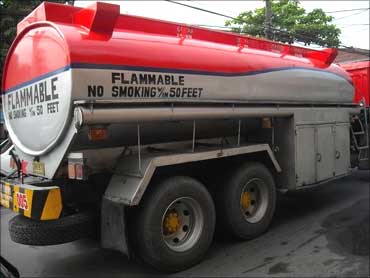 | « Back to article | Print this article |
Petrol consumption dropped in 2010-11
The sharp rise in petrol price slowed its consumption growth in 2010-11.
Last year witnessed a growth rate of 10.8 per cent against a 13.9 per cent rise in 2009-10.
Petrol prices went up by 22 per cent between April and January, prompting consumers to conserve and spend less on the fuel.
From Sunday, its price shot up by another eight per cent.
"The sharp increase in price has affected the consumption pattern," said G C Daga, director (marketing), Indian Oil Corporation.
Click NEXT to read further. . .
Petrol consumption dropped in 2010-11
While one would assume a shift in consumption from petrol to diesel must have taken place, given that the diesel price has not changed since June 25 last year, diesel growth, too, trailed behind 2009-10.
Against 8.8 per cent growth in 2009-10, diesel consumption grew 6.6 per cent in 2010-11, the lowest since 2006-07.
Diesel, which accounts for 40 per cent of overall petroleum product sales, is used by diverse sectors -- trucks (37 per cent), passenger cars (15 per cent), buses (12 per cent), agriculture (12 per cent), industry (10 per cent), power generation (8 per cent) and rail (6 per cent).
Click NEXT to read further. . .
Petrol consumption dropped in 2010-11
With the exception of agriculture and power, diesel consumption by all the other sectors saw an increase in 2010-11.
Commercial vehicle sales rose 27 per cent in the last financial year, while the index of industrial production showed 7.8 per cent growth.
"The good rains during July-October reduced diesel off-take by agriculture and the growth hovered around four per cent during those months and affected the annual average," said an official at the Petroleum Planning and Analysis Cell.
Similarly, diesel-based power generation in 2010-11 declined by 25 per cent to 2.979 billion units since power generation companies witnessed a sudden drop in agriculture and domestic loads after the arrival of good monsoon.
Click NEXT to read further. . .
Petrol consumption dropped in 2010-11
In petrol, an item of direct consumption, there has been a series of price rises after it was decontrolled in June.
Between last April-September, the price went up by about eight per cent.
Between October and January, it went up by another 11 per cent.
"In the first six months of the last financial year, petrol consumption grew nearly 12 per cent. However, the continued price increase saw the growth taper to nine per cent in the later half," said an industry official.
"A series of factors would have been responsible for the dip in growth rate -- price sensitivity to fuel, greater reliance on public transport, better road infrastructure leading to lower consumption, replacement of petrol and diesel by gas.
However, even at a growth rate of 6.6 per cent, the country would be requiring additional 3.5-4 million tonnes diesel every year," said Deepak Mahurkar, associate director, PricewaterhouseCoopers.




